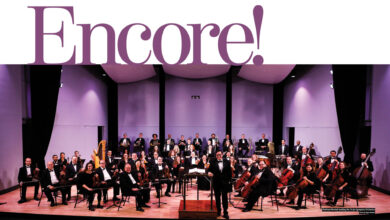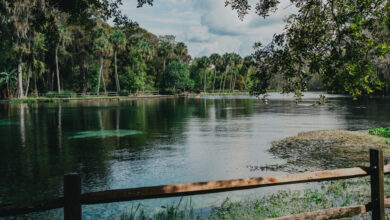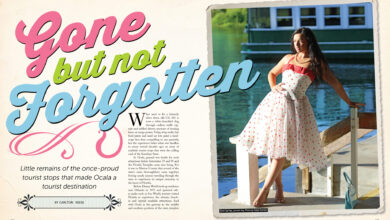Written by: Laura Lakey | Photography by: Chris Redd, Chief Photographer
If asked, I believe a good many artists would admit choosing art as a career wasn’t a conscious decision – at least not at first. Most, myself included, started off in a completely different direction, planning for a profession that would provide stability and a steady income. Personally, I wanted to be a renowned marine biologist working with Jacques Cousteau to save the endangered reefs and I could fully imagine myself doing research in mask and flippers.
I took the art detour in college, choosing electives I knew I’d enjoy. It was the seventies after all, and hadn’t I always loved to draw and paint? As a teen, to my parents’ horror, I’d adorned my room with hand rendered hippie flowers, symbols and slogans. I painted my junker car in the same psychedelic style and it’s a wonder I’d never been pulled over. Yes, I enjoyed creating and expressing myself, so fine arts was just fine for then. I would take all those troublesome math and science courses later, along with some scuba lessons.
Sometime during the next few years things changed. I guess it might have had something to do with all the art history I absorbed but I think it was the studio classes that got me. I loved the camaraderie (and the competition, if I were to be honest) of being part of a group of creative people, exchanging ideas and seeing how other people observed the world and expressed it through their art. But, oh, those critique sessions could be pretty brutal.
I have a theory there’s something in the smell of oil paints that’s addictive, at least to me. I love squeezing the paints onto a fresh palette and the feel of your brush on the canvas is positively sensual. There’s a sort of magic that happens when you create a two-dimensional construct out of canvas and pigment that appears three-dimensional to the eye, and the better you become at this trick, the more rewarding it is. Unfortunately, during the time I was in school, representational art was out of favor. Realism wasn’t the trend and illustration was a subject of teacher disdain.
Andrew Wyeth was a cultured fine artist, hanging in the New York Museum of Modern Art while Norman Rockwell was nothing more than an overpaid commercial hack. Despite my professors’ opinions, I admired the works of the classic illustrators like Rockwell, Howard Pyle, Leyendecker and others. After all, Andrew Wyeth’s own father was a famous book illustrator so what exactly was the difference? Almost all of the revered fine artists from the past worked on commissions for clients, from Michelangelo to Rembrandt to Picasso and Dali, and when clients pay for art, they usually have a good deal of input. I guess the main difference is fine artists paint to satisfy their own vision, hoping to be recognized and collected someday, while illustrators create to satisfy the needs of their clients and collect a check upon publication, and maybe residuals. I became an illustrator.
My first published illustration was for Isaac Asimov magazine in 1978. It was a full-page, black and white and paid $150 covering my rent for the month. I took a job as a television illustrator in a college media production department, and though the assignments were largely academic, I learned a great deal about technique, materials and mediums. I also fell in love with a dashing, irresponsible young art director named John Lakey. It was an event that would change my signature forever.
By the mid-nineteen-eighties we were a married couple with a rustic North Carolina studio, supporting ourselves as full time book and magazine illustrators. We literally worked for everyone possible across a wide spectrum of publications. From Amazing Stories, Heavy Metal, National Lampoon, Bantam Books, Marvel Comics, to Warren’s horror series, and a host of others, it was hectic but it was fun. We lived in a beautiful environment, the studio was tucked in a wooded cove bordering the national forest with a view of a rocky creek divided by a series of small waterfalls. We didn’t get TV reception but we didn’t miss it. We bought a hot tub.
In terms of style,John and I are one of the few long term husband/wife illustration teams because we counterbalance each other. He’s a cartoonist while I’m a realist.
He’s amazing with watercolors while I’m better in oils. A watercolor can be ruined in an instant but oil paints are easily and leisurely correctable. He’s impatient and after 32-years of marriage, clearly I’m not.
After a half-dozen years strictly freelance, John took a full time job working for Xavier Roberts, creator of the Cabbage Patch Kids. Now, with a regular check, health benefits and nothing but good intentions, we decided to have kids. We already shared custody of John’s son Sean, who had been forced into modeling since he could toddle, but we had every other week to ourselves. ”Now,” John told me, “your life is really going to change,” and for once he was right.
As a rule, we almost never turned down freelance work, especially when it was our sole source of income. With the fast turnaround times for magazine and comic art, I rarely had the chance to use oils. Once we started working for Dungeons & Dragons, they all but required it. In most cases, these were actual paintings that came with detailed descriptions of characters, armor and world view backgrounds. Our daughter Alexa was born and what seemed like chaos before paled in comparison.
Now, I was a bonafide working mom and there weren’t that many moms working from home back in the eighties. We were getting a lot of assignments. John was driving over a hundred miles each day to his Creative Director’s job in Georgia, working nights in the studio and on props and costumes for photo shoots on the weekends.
Out of necessity, we’ve often used ourselves as characters in stories we’ve illustrated. We knew how to do expressions, didn’t mind wearing makeup and costumes, and we never charged a modeling fee. However, the Dungeons & Dragons books and game modules needed specific character types and we were forced to look outside our usual circle of family and friends. Approaching a stranger and offering to pay them to pose as a cave troll or a barbarian maiden generally required tact. Telling a massive weight lifter he’d make a great ore wasn’t much easier, assuming you could even explain what an ore was, quickly. At one point, we were doing a series of books whose characters were all giants and I saw this guy in our local Winn Dixie who was over seven feet tall and broad as an ox. I gave him a card and got his number.John later pointed out I didn’t need an actual giant, because of course, I could just draw a normal sized person larger. Like I said, life was pretty hectic. We had another baby and named her Kathleen. I hired a wonderful elderly nanny and learned to paint faster.John got a vasectomy.
In the mid-nineteen-nineties we moved to Scottsdale when John was offered the position of Pre-production Designer at Fox Feature Animation. The studio brought in about 300 artists and computer designers to create state- of the art feature films Anastasia and Titan A.E. John worked closely with director Don Bluth on story and concept. And once Don learned about his extensive background in creating props and costumes, most live action shoots as well.
Scottsdale has a large and vibrant art community as well as a multitude of excellent galleries, many of which showcase western art. Once our two daughters were in grade school, John encouraged me to get into the fine arts scene – something I’d never had time to pursue. I’d always been attracted to western art and loved the history, characters, gear and saturated colors. It also involved horses! Horses are, other than bare feet, possibly the most challenging yet rewarding subjects to paint as far as I’m concerned. Luckily John’s been a failed stuntman/cowboy since the nineteen- sixties so we had ample holsters, chaps, hats, etc.
My first western painting of my stepson is still one of my favorites and I don’t think I’ll ever sell it. But I have to say, whatever anyone else might read into his sullen expression, I recognize it for the usual, “Take the photo already!” look I’ve come to love over the years. I did a whole series of historical western paintings, concentrating on character rather than location. While I can paint landscapes, they’ve never really held my interest that much. What drives me as a painter, is trying to capture what comes through a subject’s eyes. I believe you can tell a whole story through expression and body posture so, I guess in a sense, these paintings are a form of illustration as well.
The historical series did very well in Scottsdale. It won some awards and things were going along swimmingly when I was diagnosed with breast cancer. I don’t talk about it much because although I did go through surgery and radiation, I was so lucky to have a very small, very slow-growing cancer. So many women have endured much worse. However, going through the experience made me reevaluate a lot of things – important things – like how fleeting and precious life is and what the heck am I doing with mine?! I decided that though I’d continue to paint the more serious subjects I’d been focusing on, I would start a series of paintings that simply made people smile and thus my retro cowgirls were born.
My inspiration for the cowgirl paintings was twofold. I wanted to honor the historical tradition of illustration and my participation in it, but I also really love the whole B western aesthetic. It’s been great fun trying to recreate the look of the pulp magazine covers and movie posters from the nineteen- fourties and fifties while putting my own take on things. And now whenever we go out, I scout the restaurant tables and checkout lines for potential cowgirls, though it’s still hard to pass up a good giant!
After living across the country from my folks for almost nineteen years we decided it would be great to be closer to them. We relocated to Ocala about a year ago and so far we love it. I’ve joined the Ocala Art Group and hope to get more involved in the local art scene, time permitting. I’m very open to taking commissions, both in portraiture and possibly some owner and horse portraiture as well. I truly am always looking for models, so if a tall lady approaches you about modeling for a painting it’s probably me but all things considered, I’d still ask to see some I.D.!






